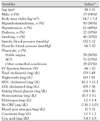1. Ebrahim S, Papacosta O, Whincup P, et al. Carotid plaque, intima media thickness, cardiovascular risk factors, and prevalent cardiovascular disease in men and women. Stroke. 1999. 30:841–850.
2. Poli A, Tremoli E, Colombo A, Sirtori M, Pignoli P, Paoletti R. Ultrasonographic measurement of the common carotid artery wall thickness in hypercholesterolemic patients. A new model for the quantitation and follow-up of preclinical atherosclerosis in living human subjects. Atherosclerosis. 1988. 70:253–261.
3. Bae JH, Seung KB, Jung HO, et al. Analysis of Korean carotid intima-media thickness in Korean healthy subjects and patients with risk factors: Korea multi-center epidemiological study. Korean Circ J. 2005. 35:513–524.
4. Smith SC Jr, Greenland P, Grundy SM. Identifying the high-risk patient for primary prevention. Circulation. 2000. 101:111–116.
5. Bots ML, Grobbee DE. Intima media thickness as a surrogate maker for generalised atherosclerosis. Cardiovasc Drugs Ther. 2002. 16:341–351.
6. Simon A, Gariepy J, Chironi G, Megnien JL, Levenson J. Intima-media thickness: a new tool for diagnosis and treatment of cardiovascular risk. J Hypertens. 2002. 20:159–169.
7. O'Leary DH, Polack JF, Kronmal RA, Manolio TA, Burke GL, Wolfson SK. Carotid artery intima and media thickness as a risk factor for myocardial infarction and stroke in older adults. N Engl J Med. 1999. 340:14–22.
8. Bae JH, Kim WS, Rihal CS, Lerman A. Individual measurement and significance of carotid intima, media, and intima-media thickness by B-mode ultrasonographic image processing. Arterioscler Thromb Vasc Biol. 2006. 26:2380–2385.
9. Hyun DW, Bae JH, Kim KY, Hwang IK, Kim WS. Measurement of the Carotid Intima, Media and Intima-Media Thickness with Ultrasound and New Software. Korean Circ J. 2005. 35:625–632.
10. Libby P. Vascular biology of atherosclerosis: overview and state of the art. Am J Cardiol. 2003. 91:3–6.
11. Schachter M. The pathogenesis of atherosclerosis. Int J Cardiol. 1997. 62:3–7.
12. Tracy RE. Medial thickness of coronary arteries as a correlate of atherosclerosis. Atherosclerosis. 1998. 139:11–19.
13. Stary HC, Chandler B, Glagov S, et al. A definition of the intima of initial, fatty streak, and intermediate lesions of atherosclerosis. A report from the committee on vascular lesions of the council on atherosclerosis. American Heart Association. Arterioscler Thromb. 1994. 14:840–856.
14. Stary HC, Blankenhorn DH, Chandler AB, et al. A definition of the intima of human arteries and of its atherosclerosis-prone regions. A report from the committee on vascular lesions of the council on atherosclerosis, American Heart Association. Arteriosclerosis. 1992. 12:120–134.
15. Stary HC, Chandler B, Dinsmore RE, et al. A definition of the intima of advanced types of atherosclerotic lesions and a histological classification of atherosclerosis. A report from the committee on vascular lesions of the council on atherosclerosis, American Heart Association. Circulation. 1995. 92:1355–1374.
16. Ross R. The pathogenesis of atherosclerosis: a perspective for the 1990s. Nature. 1993. 362:801–809.
17. Homma S, Ishii T, Tsugane S, Hirose N. Different effects of hypertension and hypercholesterolemia on the natural history of aortic atherosclerosis by the stage of intimal lesions. Atherosclerosis. 1997. 128:85–95.
18. Touboul PJ. Clinical impact of intima-media measurement. Eur J Ultrasound. 2002. 16:105–113.
19. Homma S, Ishii T, Malcom GT, et al. Histopathological modifications of early atherosclertic lesions by risk factors-findings in PDAY subjects. Atherosclerosis. 2001. 156:389–399.
20. Zeiher AM, Drexler H, Wollschlager H, Just H. Modulation of the coronary vasomotor tone in humans: progressive endothelial dysfunction with different early stages of coronary atherosclerosis. Circulation. 1991. 83:391–401.








 PDF
PDF ePub
ePub Citation
Citation Print
Print


 XML Download
XML Download